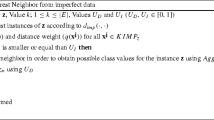Abstract
Soft labels allow a pattern to belong to multiple classes with different degrees. In many real world applications the association of a pattern to multiple classes is more realistic; to describe overlap and uncertainties in class belongingness. The objective of this work is to develop a fuzzy Gaussian process model for classification of soft labeled data. Gaussian process models have gained popularity in the recent years in classification and regression problems and are example of a flexible, probabilistic, non-parametric model with uncertainty predictions. Here we derive a fuzzy Gaussian model for a two class problem and then explain how this can be extended to multiple classes. The derived model is tested on different fuzzified datasets to show that it can adopt to various classification problems. Results reveal that our model outperforms the fuzzy K-Nearest Neighbor (FKNN), applied on the fuzzified dataset, as well as the Gaussian process and the K-Nearest Neighbor models used with crisp labels.
Preview
Unable to display preview. Download preview PDF.
Similar content being viewed by others
References
El Gayar, N., Schwenker, F., Palm, G.: A study of the robustness of knn classifiers trained using soft labels. In: Schwenker, F., Marinai, S. (eds.) ANNPR 2006. LNCS, vol. 4087, pp. 67–80. Springer, Heidelberg (2006)
Pal, S., Mitra, S.: Multilayer perceptron, fuzzy sets and classification. IEEE Transactions on Neural Networks 3, 683–697 (1992)
El Gayar, N.: Fuzzy Neural Network Models for Unsupervised and Confidence-Based Learning. PhD thesis, Dept. of Comp. Sc., University of Alexandria (1999)
Keller, J., Gray, M., Givens, J.: A fuzzy k-nearest algorithm. IEEE Transactions on Pattern Analysis and Machine Intelligence 7, 693–699 (1985)
Kuncheva, L.: Fuzzy classifier design. Physica-verlag (2000)
Lin, C., Wang, S.: Fuzzy support vector machines. IEEE Transactions on Neural Networks 13, 464–471 (2002)
Borasca, B., Bruzzone, L., Carlin, L., Zusi, M.: A fuzzy-input fuzzy-output svm technique for classification of hyperspectral remote sensing images. In: NORSIG 2006, Reykjavk (2006)
Thiel, C., Scherer, S., Schwenker, F.: Fuzzy-input fuzzy-output one-against-all support vector machines. In: Apolloni, B., Howlett, R.J., Jain, L. (eds.) KES 2007, Part III. LNCS, vol. 4694, pp. 156–165. Springer, Heidelberg (2007)
Seo, S., Obermayer, K.: Soft learning vector quantization. Neural Computation 15, 1589–1604 (2003)
Villmann, T., Hammer, B., Schleif, F., Geweniger, T.: Fuzzy labeled neural gas for fuzzy classification. In: WSOM 2005, Paris, France, September 2005, pp. 283–290 (2005)
Villmann, T., Schleif, F., Hammer, B.: Fuzzy labeled soft nearest neighbor classification with relevance learning. In: ICMLA 2005, December 2005, pp. 11–15. IEEE Press, Los Angeles, USA (2005)
Thiel, C., Sonntag, B., Schwenker, F.: Experiments with supervised fuzzy lvq. In: Prevost, L., Marinai, S., Schwenker, F. (eds.) ANNPR 2008. LNCS, vol. 5064, pp. 125–132. Springer, Heidelberg (2008)
Nickisch, H., Rasmussen, C.: Approximations for binary gaussian process classification. Journal of Machine Learning Research 9, 2035–2078 (2008)
Rasmussen, C., Williamsm, C.: Gaussian Processes for Machine Learning. MIT Press, Cambridge (2006)
Fisher, R.: The use of multiple measurements in taxonomic problems. Annual Eugenics 7, Part II, 179–188 (1936)
Murphy, P., Aha, D.: UCI repository of machine learning databases. PhD thesis, University of California, Dept. of Information and Computer Science, Irvine, CA (1992)
Merz, J., Murphy, P.: UCI repository of machine learning databases (1996), http://www.ics.uci.edu/learn/MLRepository.html
Author information
Authors and Affiliations
Editor information
Editors and Affiliations
Rights and permissions
Copyright information
© 2009 Springer-Verlag Berlin Heidelberg
About this paper
Cite this paper
Ahmed, E., El Gayar, N., Atiya, A.F., El Azab, I.A. (2009). Fuzzy Gaussian Process Classification Model. In: Kamel, M., Campilho, A. (eds) Image Analysis and Recognition. ICIAR 2009. Lecture Notes in Computer Science, vol 5627. Springer, Berlin, Heidelberg. https://doi.org/10.1007/978-3-642-02611-9_37
Download citation
DOI: https://doi.org/10.1007/978-3-642-02611-9_37
Publisher Name: Springer, Berlin, Heidelberg
Print ISBN: 978-3-642-02610-2
Online ISBN: 978-3-642-02611-9
eBook Packages: Computer ScienceComputer Science (R0)




